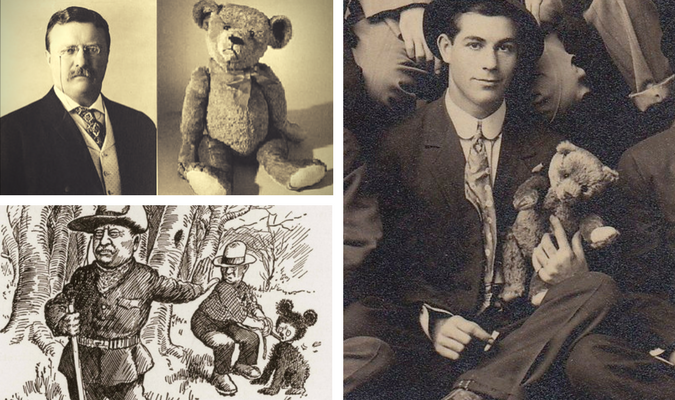When Theodore Roosevelt came upon a bear that was trapped (or some reports say he was tied) to a tree, his hunting party urged him to shoot the animal. The U.S. President would have none of it. He insisted it wouldn't be sporting.
A newspaper subsequently published a cartoon depicting the incident. Spurred by the cartoon, which showed Roosevelt turning his back (and his gun) away from a cute little bear cub, an enterprising entrepreneur made a fuzzy toy and dubbed it "Teddy's Bear." That was 1902 and it was Christmas, and the entrepreneur, a man named Morris Michtom, eventually established a toy empire, largely built on what would be called the teddy bear.
A little bit of housekeeping: Roosevelt's hunting trip was a political maneuver to appease the Governor of Mississippi, who had been having a rough time after some unpopular decisions. The Governor, a dapper man with a bushy mustache named Andrew Longino, hoped that the beloved Roosevelt would shoot lots of animals in the woods of his state and garner press attention. Roosevelt shot lots of things. Secondly, Michtom was a Jewish-American immigrant who scraped together enough money to open a candy shop in Brooklyn in the late 19th century. A man of inspiration, when he saw the cartoon of Roosevelt (drawn by famed Washington cartoonist Clifford Berryman, the fella whose cartoon of the explosion of the USS Maine helped start the Spanish-American War), he got his wife Rosie to stitch together the little stuffed bears he designed in the backroom of his candy shop. Lastly, President Roosevelt had many nicknames: some people called him TR, his close family called him "Teedie", his children called him "Papa", but he hated the nickname "Teddy".
As often happens with these things, a second inventor created a "teddy bear" at the same time as Michtom. His name was Richard Steiff, a wildlife artist living in Germany. Steiff was one of those young men who found himself daydreaming a lot while he tried to figure out what he wanted to be when he grew up. As an art student in Stuggart, he often spent the time he should have been studying at the zoo, where he liked to sketch the bears he saw there. When he saw the Berryman cartoon he was prompted to design a prototype for a stuffed bear with moveable limbs. In 1904 he sold 12,000 of his Teddy Bears at the World's Fair in St. Louis, which was opened by Roosevelt and attracted nearly 20 million people in seven months.
Two other milestones helped increase the popularity of the Teddy Bear. In 1905, Seymour Eaton launched a book series titled "The Roosevelt Bears", which sort of became the Harry Potter of its time; and in 1907, composer John Walter Bratton penned a song called "Teddy Bears' Picnic", which became a hit. Bratton reportedly hated the song (he wanted a mainstream hit and considered the tune to be for kids), but he didn't balk when checks started coming in.
In those first few years, Teddy Bears were made to look more like actual bears, with long snouts and small eyes. Many were made to look like black and brown bears, grizzly bears and panda bears, and even polar bears. Later, through the popularity of Steiff's design, the bears had larger eyes and small noses and were formed to be huggable. The fur evolved into the light, fuzzy brown that we know today.

In 1926, British author A.A. Milne wrote "Winnie-the-Pooh", which was followed quickly by "The House at Pooh Corner" and two other collections of stories about a boy and his teddy bear who comes to life. Once Disney purchased the rights to the series they produced ten films starring Pooh starting in 1966.
In both World War I and World War II, soldiers were known to bring teddy bears into the battle zone with them, either for comfort, as a reminder of home, or as a mascot. In the popular television show M*A*S*H*, Corporal Walter "Radar" O'Reilly slept with a teddy bear during his time in the Korean War.
By the 1950s, Teddy Bears were so popular that they'd become one of the ten best selling toys annually. A new word was coined: an "arctophile" is a person who loves teddy bears. In subsequent years several teddy bears entered pop culture, including Paddington Bear, Corduroy, Teddy Ruxpin, and The Care Bears. They became prominent in advertising (Snuggle bears), food (gummy bears) and even horror ("Dolls" in 1977 and the horrifying "Teddy" in 2011).
Today, the Teddy bear industry is worth more than $1 billion annually. Teddy bears are all over the place, and still delighting young people all around the globe.
- - - - - - - - -
See our foam-filled bean bag chairs with a Teddy Bear fur covering.

Leave a comment